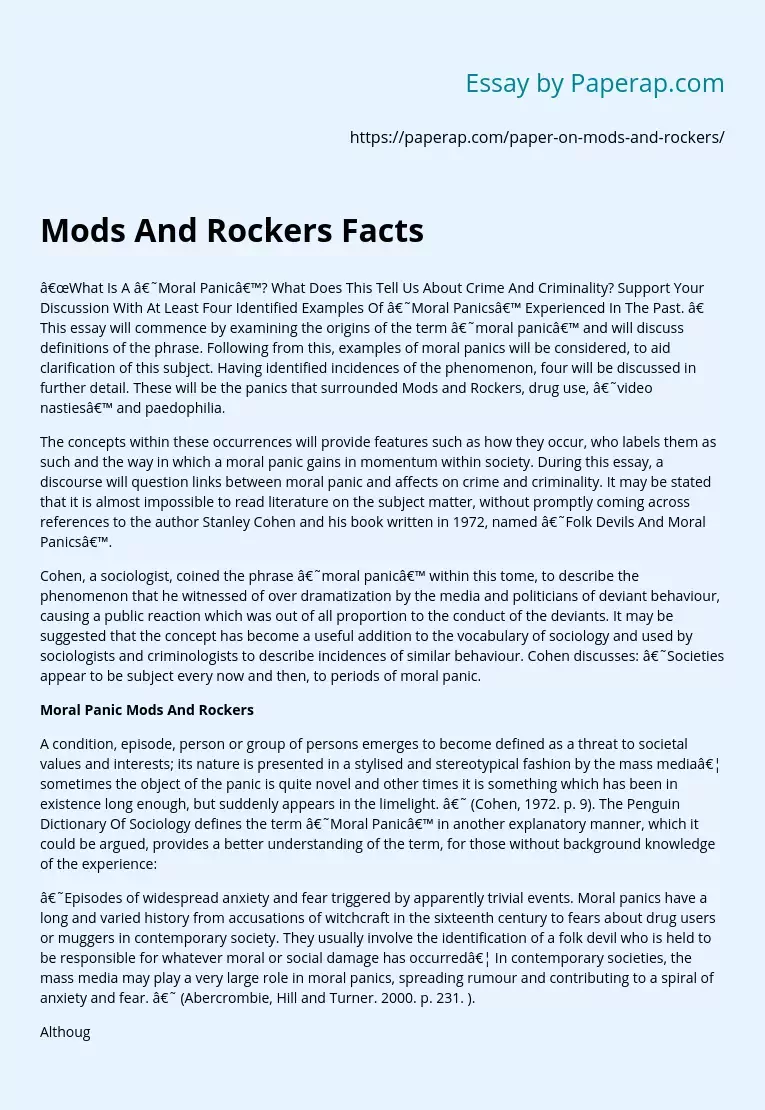Mods And Rockers Facts
“What Is A ‘Moral Panic’? What Does This Tell Us About Crime And Criminality? Support Your Discussion With At Least Four Identified Examples Of ‘Moral Panics’ Experienced In The Past. ” This essay will commence by examining the origins of the term ‘moral panic’ and will discuss definitions of the phrase. Following from this, examples of moral panics will be considered, to aid clarification of this subject. Having identified incidences of the phenomenon, four will be discussed in further detail. These will be the panics that surrounded Mods and Rockers, drug use, ‘video nasties’ and paedophilia.
The concepts within these occurrences will provide features such as how they occur, who labels them as such and the way in which a moral panic gains in momentum within society. During this essay, a discourse will question links between moral panic and affects on crime and criminality. It may be stated that it is almost impossible to read literature on the subject matter, without promptly coming across references to the author Stanley Cohen and his book written in 1972, named ‘Folk Devils And Moral Panics’.
Cohen, a sociologist, coined the phrase ‘moral panic’ within this tome, to describe the phenomenon that he witnessed of over dramatization by the media and politicians of deviant behaviour, causing a public reaction which was out of all proportion to the conduct of the deviants. It may be suggested that the concept has become a useful addition to the vocabulary of sociology and used by sociologists and criminologists to describe incidences of similar behaviour.
Cohen discusses: ‘Societies appear to be subject every now and then, to periods of moral panic.
Moral Panic Mods And Rockers
A condition, episode, person or group of persons emerges to become defined as a threat to societal values and interests; its nature is presented in a stylised and stereotypical fashion by the mass media… sometimes the object of the panic is quite novel and other times it is something which has been in existence long enough, but suddenly appears in the limelight. ‘ (Cohen, 1972. p. 9). The Penguin Dictionary Of Sociology defines the term ‘Moral Panic’ in another explanatory manner, which it could be argued, provides a better understanding of the term, for those without background knowledge of the experience:
‘Episodes of widespread anxiety and fear triggered by apparently trivial events. Moral panics have a long and varied history from accusations of witchcraft in the sixteenth century to fears about drug users or muggers in contemporary society. They usually involve the identification of a folk devil who is held to be responsible for whatever moral or social damage has occurred… In contemporary societies, the mass media may play a very large role in moral panics, spreading rumour and contributing to a spiral of anxiety and fear. ‘ (Abercrombie, Hill and Turner. 2000. p. 231. ).
Although this definition seemingly provides a further understanding of the term, it could be understood that the source is firmly entrenched within Cohen’s findings. Since Cohen’s study, it may be agreed that a great many ‘folk devils and moral panics’ have been identified. It could be argued that major concern has been mounted regarding issues such as drugs, football hooliganism, asylum seekers, AIDS and homosexuality, paedophiles, pornography, teenage pregnancy, ‘video nasties’ and youths, to name but a few. Cohen’s influential study commenced primarily with two youth groups of the 1960’s, the ‘Mods’ and ‘Rockers’.
The Mods were neat, chic and cool. The Rocker was mean, moody and masculine (Teenage Kicks. n. d. ). Burns mentions in her study that on Easter bank holiday, 1964 in Clacton, Essex, the groups clashed. The conflict caused a number of beach huts to be damaged, windows broken and ‘scuffles’ to break out resulting in ninety-seven arrests. During the following week, national newspapers grabbed attention of readers with headlines such as “Day Of Terror By Scooter Groups” and “Wild Ones Invade Seaside – 97 Arrests”. Phrases such as ‘orgy’, riot’ ‘siege’ and ‘screaming mob’ were included.
Thus, sensationalised by the press with exaggeration of facts and numbers, came a supposition by society that the event was a more violent incident than the facts supported (Burns, 2000). Burns states that Cohen criticised the media for the amplification of the situation, which caused Mods and Rockers to be seen as a threat to law and order. He named this theory ‘control culture’, an incident whereby the media purposely sensationalise an event and then call for punishment of the perpetrators, creating ‘folk devils’ amongst society (Burns, 2000. ). Richard Ives (n. d.
) argues that on following bank holidays, public panic came to be out of all proportion to the size of the problem. Young people were turned away from the beaches; youths were reported to the police and punitive measures such as fines were put into place, which were disproportionate to offences committed. These reactions caused more arrests, more tension between the groups and further incidences throughout the country (Ives, n. d. ). It may be stated that this moral panic therefore had a direct impact upon crime and criminality, causing a ‘self fulfilling prophecy’.
Ives mentions that ‘eventually, the moral panic over Mods and Rockers died away. What stopped it? From the point of view of the public and mass media, it was largely a waning of interest. Mods and Rockers as folk devils were replaced by other new and newsworthy phenomenon. ‘ (Ives, n. d. ). Before looking more closely at three further incidences of moral panics, it could be considered important to look at the way in which moral panics can be broken down into five elements, which define it: concern, hostility, consensus, disproportionality and volatility (Goode and Ben-Yehuda 1994, p. 33-40).
Mods And Rockers Facts. (2019, Dec 05). Retrieved from https://paperap.com/paper-on-mods-and-rockers/

